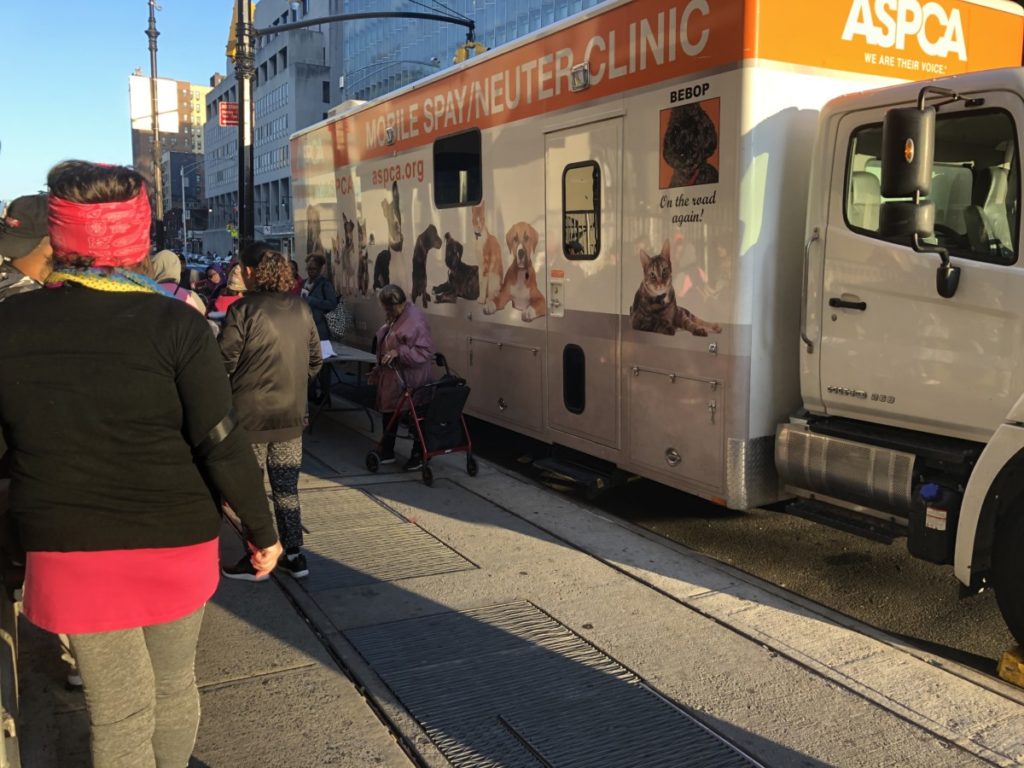
At 6 a.m., the sky began to light up as Perla Medina darted around a line that had already formed at the mobile vet clinic that wouldn’t arrive for another hour at St. Mary’s Park in the Bronx. It was Thursday, and the clinic’s monthly visit to the park.
Medina wore a gray hoodie and held a loose sheet of lined notebook paper and a pen. As people arrived, the 13-year-old took their name and asked how many pets they had with them.
It was Medina and her sister, Daniella Estevez’s, third time at The American Society of Prevention of Cruelty to Animals mobile clinics and after two unsuccessful trips they wanted to make sure their two cats get a spot in line. Medina was taking names so that when the clinic arrived, the veterinarian technicians would know who’d been in line first. She didn’t want the others to wait unnecessarily if there was no hope for them to be seen.
The first time, she and her sister waited for two hours, according to Estevez, a 17-year-old high school student. The second time they happened to be number 26, out of 25 served.
“We could get there as early as we want, but we were always one behind the last person taken,” Medina said. .
The ASPCA currently has four ASPCA Mobile Spay/Neuter Clinics located at rotating locations throughout New York City, but can only accommodate up to 25 animals per day, according to ASPCA Media and Communications.
A community veterinary center is expected to open in the South Bronx next spring to improve access to veterinarian services for lower income people. The American Society for the Prevention of Cruelty is spending $45 million on three new facilities. Each will provide free care to to cat and dog owners who have proof of public assistance or public housing, and subsidized services for others.
The center will be the first of its kind in New York City, followed by others scheduled to open in Brooklyn and Manhattan in 2020 and 2021 respectively, according to an ASPCA press release.
The cost of pet care is rising – with pet owners spending more than $18 billion on veterinary care last year, a billion-dollar increase over the year before, according to American Pets Project Association.
The communities that use the ASPCA mobile clinics hope the new centers will be able to address some of the issues with the mobile clinics such as long wait times with the risk of not being seen.
Waiting to be seen
While Medina and her sister were lucky on their third trip and were able to have both of their cats Oreo and Storm seen, it was not the case for everyone.
While mobile clinics arrive at their rotating locations throughout the boroughs at 7 a.m., owners are recommended to arrive in advance, according to the Bronx September ASPCA calendar. Customers of ASPCA said they regularly arrived as early as 4:30 a.m. to guarantee a spot on the list.
Medina and Estevez arrived at 5 a.m. and were the sixth people in line for the 7 a.m. clinic.
More Animals Served
Not a morning person, Emilia Rodriguez held her cat carrier and bounced up and down, trying to stay awake. This was her fourth visit to the mobile clinic as she got her last cat Little Bit, a stray from a funeral home, fixed.
“The clinics around here charge $100-$200 and here getting pets fixed is free,” said Rodriguez, a cashier at Family Dollar. “It’s really awesome for low income people. I have nothing bad to say about this truck. I’m serious. This truck is a god send.”
On average, people spend $1,300 per dog and $900 per cats every year, according to a study by TD Ameritrade. But, the monthly average spent on pets in New York at $157 is higher than the national average, according to a study by Opploans.
The clinics are open every Tuesday through Saturday, with at least one clinic in each borough, and with two clinics in the Bronx every Tuesday and Friday, according to the ASPCA website.
The ASPCA declined to cite how many animals were served in New York City in a year, but said it was in the tens of thousands.
Once the three community centers are open, ASPCA expects to provide an additionally 30,000 spay/neuter services every year. The centers won’t replace the clinics, but will supplement their services.
Expanded Services
Samantha Arroyo held her small grey and white splotched cat in a pink carrier close to her. It was her second time in line at the mobile clinic. Arroyo was called in, but soon after she was sent back out again.
The clinic couldn’t fix her cat because it had pus in his mouth. She’ll have to go to another veterinarian and come back again. She had been turned away for the same reason the last time she was at there.
With the new community centers, it is possible that Arroyo could have had her cat treated and fixed at the same location, instead of visiting another vet, according to the ASPCA press release.
Currently the clinics offer spay or neuter surgeries, vaccinations, nail trims and microchip placement, according to the ASPCA spokesperson. The community centers will expand their services, but it is unclear what additional services the clinics will offer and ASPCA declined further requests for information, including why the center opening was delayed. It was originally slated to open this fall.


